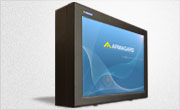Keeping Outdoor Displays Warm
Posted by: Richard Williams | Posted on: | 0 Comments
Whether it is for information, advertising or another form of outdoor digital signage, LCD screens provide an ideal platform. Up-to-the-minute information is easily relayed on a networked screen, which is why they are now a common sight in many transport hubs such as bus and train stations.
Of course, any screen placed outside or on a station platform is going to need protecting against the elements, and while waterproof LCD screens can withstand rainfall and other weather elements, coping with the temperatures of an outdoor environment is more challenging.
Winter temperatures vary around the globe. While some countries endure only mild weather, others suffer extreme weather during the winter with temperatures well below zero. Modern LCD screens are not suitable for these extreme conditions, with sub-zero temperatures liable to cause failure, possibly permanently.
Coping with extreme cold is not easy, and many screens, even those designed for outdoor use, cannot operate in extremely cold temperatures. Most LCD screens have an optimum temperature range and this must not be breached, even for brief periods. Fortunately, using an LCD enclosure enables the use of various solutions to cope with extreme cold, depending on the conditions.
Keeping a screen warm and above its minimum operating level requires different approaches for different locations, depending on how cold it gets. For some locations, the simplest method of maintaining a screen’s temperature is to use the heat generated by the screen itself. All LCD screens generate a heat when in operation, so if the screen is continuously left on, this heat can help keep the temperature inside the enclosure above the minimum. To help with this, LCD enclosures are often fitted with insulation, preventing the heat escaping too rapidly, maintaining the internal temperature.
In other locations, or when the screen is turned off, the heat generated from an LCD screen may not be enough to maintain the minimum operating temperature. In these circumstances, thermostatically controlled heaters are mounted inside the LCD enclosure and operate automatically when the temperature drops below a set threshold.
No matter how cold the location, an LCD enclosure can be customized to ensure the optimum operating temperature for almost any type of screen, permitting outdoor screen use even in the coldest of locations.
Post shortlink:
Popular Products
LCD Enclosure
Need armor for your LCD/LED screen(s)? Outdoors or inside the versatile LCD enclosure protects against thieves, vandals & the weather. Installation idea: NFL stadiums.
Outdoor Digital Signage
Exclusive 46” outdoor screen protection. Dubbed the ‘Totem’, due to its distinct design, it repels damage threats, but attracts audiences. Installation idea: Drive-thru restaurants.
Portrait Flat Panel Enclosure
Safeguard your eye-level advertising display screen(s), indoors or outdoors. Completely customizable, add exciting features like touch screen technology. Installation idea: Restaurant frontages.
Indoor Digital Signage
Popular purchase for retail outlets! Great for ‘point of sale’ persuasion, boost your brand with static & motion advertising from a single unit! Installation idea: Mall of America.





